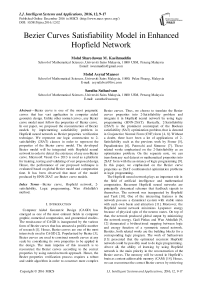Bezier Curves Satisfiability Model in Enhanced Hopfield Network
Автор: Mohd Shareduwan M. Kasihmuddin, Mohd Asyraf Mansor, Saratha Sathasivam
Журнал: International Journal of Intelligent Systems and Applications(IJISA) @ijisa
Статья в выпуске: 12 vol.8, 2016 года.
Бесплатный доступ
Bezier curve is one of the most pragmatic curves that has vast application in computer aided geometry design. Unlike other normal curves, any Bezier curve model must follow the properties of Bezier curve. In our paper, we proposed the reconstruction of Bezier models by implementing satisfiability problem in Hopfield neural network as Bezier properties verification technique. We represent our logic construction to 2-satisfiability (2SAT) clauses in order to represent the properties of the Bezier curve model. The developed Bezier model will be integrated with Hopfield neural network in order to detect the existence of any non-Bezier curve. Microsoft Visual C++ 2013 is used as a platform for training, testing and validating of our proposed design. Hence, the performance of our proposed technique is evaluated based on global Bezier model and computation time. It has been observed that most of the model produced by HNN-2SAT are Bezier curve models.
Bezier curve, Hopfield network, 2-satisfiability, Logic programming, Wan Abdullah's method
Короткий адрес: https://sciup.org/15010880
IDR: 15010880
Список литературы Bezier Curves Satisfiability Model in Enhanced Hopfield Network
- G. Farin, A history of curves and surfaces. Handbook of Computer Aided Geometric Design, Elsevier, 2002.
- A. Riškus, & G. Liutkus, An Improved Algorithm for the Approximation of a Cubic Bezier Curve and its Application for Approximating Quadratic Bezier Curve. Information Technology and Control, 42(4), pp. 303-308, 2013.
- B. T. Bertka, An Introduction to Bezier Curves, B-Splines, and Tensor Product Surfaces with History and Applications. University of California Santa Cruz, May 30th, 2008.
- R.A. Kowalski, Logic for Problem Solving. New York: Elsevier Science Publishing, 1979.
- T. Feder, Network flow and 2-satisfiability, Algorithmica, 11(3), pp. 291-319, 1994.
- C. H. Papadimitriou, On selecting a satisfying truth assignment. In Foundations of Computer Science, 1991. Proceedings., 32nd Annual Symposium, pp. 163-169, 1991.
- R. Petreschi, & B. Simeone, Experimental comparison of 2-satisfiability algorithms. Revue française d'automatique, d'informatique et de recherche opérationnelle, Recherche opérationnelle, 25(3), pp. 241-264, 1991.
- W. Fernandez, Random 2-SAT: Result and Problems, Theoretical Computer Science, 265, pp. 131-146, 2001.
- W.A.T. Wan Abdullah, Logic Programming on a Neural Network. Malaysian Journal of computer Science, 9 (1), pp. 1-5, 1993.
- J. J. Hopfield, D. W. Tank, Neural computation of decisions in optimization problem, Biological Cybernatics, 52, pp. 141-152, 1985.
- S. Haykin, Neural Networks: A Comprehensive Foundation, New York: Macmillan College Publishing, 1999.
- G. Pinkas, R. Dechter, Improving energy connectionist energy minimization, Journal of Artificial Intelligence Research, 3, pp. 223-15, 1995.
- S. Sathasivam, Upgrading Logic Programming in Hopfield Network, Sains Malaysiana, 39, pp. 115-118, 2010.
- S. Sathasivam, Energy Relaxation for Hopfield Network with the New Learning Rule, International Conference on Power Control and Optimization, pp. 1-5, 2009.
- S. Sathasivam, P.F. Ng, N. Hamadneh, Developing agent based modelling for reverse analysis method, 6 (22), pp. 4281-4288, 2013.
- S. Sathasivam, Learning in the Recurrent Hopfield Network, Proceedings of the Fifth International Conference on Computer Graphics, Imaging and Visualisation, pp. 323-328, 2008.
- R. Rojas, Neural Networks: A Systematic Introduction. Berlin: Springer, 1996.
- G. Pinkas, Propositional non-monotonic reasoning and inconsistency in symmetric neural networks. Washington University, Department of Computer Science, 1991.
- K. G. Jolly and R. S. Kumar, A Bezier curve based path planning in a multi-agent robot soccer system without violating the acceleration limits, Robotics and Autonomous System, 57(1), pp. 23-33, 2009.
- G. Farin, Curves and Surfaces for Computer-Aided Geometric Design: A Practical Guide, Elsevier, 2014.
- Patterson and R. Richard, Projective Transformations of the Parameter of a Bernstein-Bezier Curve, ACM Transactions on Graphics, TOG, 4(4), pp. 276-290, 1985.
- F. A. Robin, Interactive Interpolation and Approximation by Bezier Polynomials, 15(1), pp. 71-79, 1972.
- Bohm, Wolfgang, G. Farin, J. Kahmann, A survey of curve and surface methods in CAGD: Computer Aided Geometric Design 1, 1, pp. 1-60, 1984.
- A. Marc, Linear Combination of Transformation, ACM Transaction on Graphics, TOG 21(3), pp. 380-387, 2002.
- S.M. Hu, G. Z. Wang, T.G. Jin, Properties of two types of generalized Ball curves: Computer-Aided Design 28, 2, pp. 125-133, 1996.
- C.H. Chu, H. S. Carlo, Developable Bezier patches: properties and design: Computer-Aided Design 34, 7, pp. 511-527, 2002.
- J. Gu, Local Search for Satisfiability (SAT) Problem, IEEE Transactions on Systems, Man and Cybernetics, vol. 23 pp. 1108-1129, 1993.
- R. Puff, J. Gu, A BDD SAT solver for satisfiability testing: An industrial case study, Annals of Mathematics and Artificial Intelligence, 17 (2), pp. 315-337, 1996.
- A. Cimatti, M. Roveri, Bertoli. P, Conformant planning via symbolic model checking and heuristic search, Artificial Intelligence, 159 (1), pp. 127-206, 2004.
- A. D. Pwasong and S. Sathasivam, Forecasting Performance of Random Walk with Drift and Feed Forward Neural Network Models, International Journal of Intelligent System and Application, vol. 23 pp. 49-56, 2015.
- D. Vilhelm, J. Peter, & W. Magnus, Counting models for 2SAT and 3SAT formulae. Theoretical Computer Science, 332 (1), pp. 265-291, 2005.
- B. Sebastian, H. Pascal and H. Steffen, Connectionist model generation: A first-order approach, Neurocomputing 71(13) (2008) 2420-2432.
- H. Asgari, Y. S. Kavian, and A. Mahani, A Systolic Architecture for Hopfield Neural Networks. Procedia Technology, 17 (2014) 736-741.
- Y. L. Xou and T. C. Bao, Novel global stability criteria for high-order Hopfield-type neural networks with time-varying delays, Journal of Mathematical Analysis and Applications 330 (2007) 144-15.
- K. Iwama, “CNF Satisfiability Test by Counting and Polynomial Average Time,” SIAM, Journal of Computer, vol. 4, no. 1, pp. 385-391, 1989.


